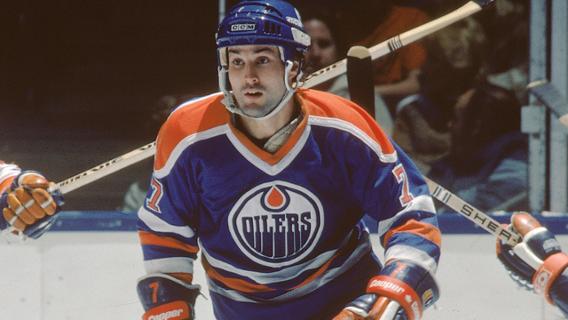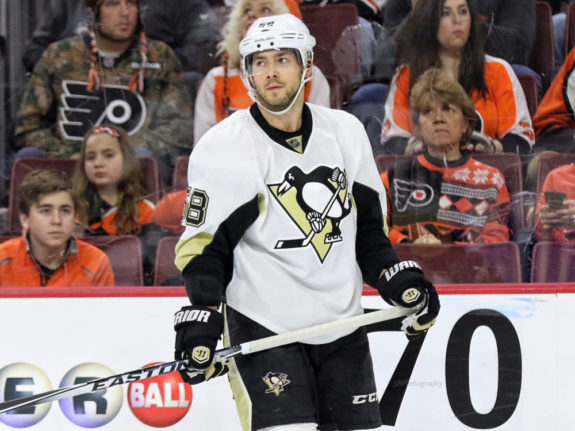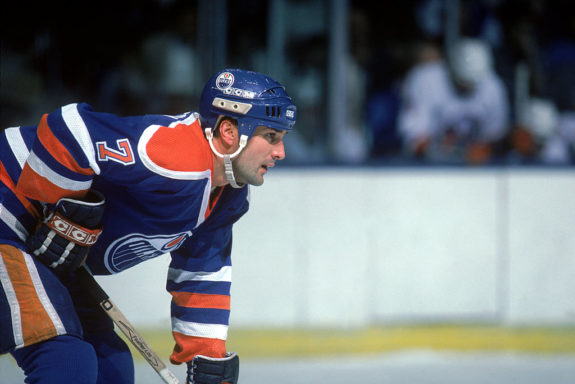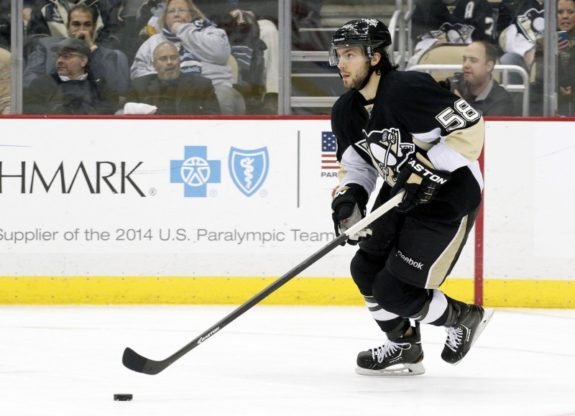Analyzing the play and value of Kris Letang has been a much-discussed and much-debated topic in Pittsburgh Penguins circles for years. Is he elite? Should he be traded? Can he overcome his health issues? How does he stack up to other, and now younger, defensemen? How does he compare to older legends like Paul Coffey?
The last question is timely as Letang is tied with Coffey for the most goals scored by a Penguins defenseman (108), and is looking to surpass that mark with each upcoming game.
GOAL! LETANG! His 108th career goal ties Paul Coffey for the franchise-record for goals by a defenseman.
The Penguins hold the 4-0 lead. pic.twitter.com/UfO6il1tyW
— Pittsburgh Penguins (@penguins) January 31, 2019
While it seems easy to draw comparisons and point out differences between two of the best-known defensemen in Pittsburgh hockey history – Letang even does so himself – the sheer act of trying to equate players from two different eras starts the discussion on unfair ground.
The Paul Coffey Era (1980 – 2001)
Before coming to the Penguins during the 1987-88 season, Coffey played six-and-a-half seasons with the Edmonton Oilers during their dynasty years and helped the team reach its first three Stanley Cup victories in 1984, 1985 and 1987.
In personal accolades, Coffey won the Norris Trophy for best defenseman twice with the Oilers (1984-85 & 1985-86), was named an NHL First-Team All-Star two times, a Second-Team All-Star two times and appeared in five All-Star Games. He also set a record for most regular-season goals in a season by a defenseman (48) in 1985-86 and a record for the most playoff goals, assists and points scored by a defenseman in the 1985 Stanley Cup Playoffs.
It is easier, however, to shine when playing for a successful team, and while playing with the greatest player in the world, Wayne Gretzky. The true skill of a player shows in adverse situations, which is what some considered a move to the Penguins to be for Coffey.

To go from playing with the best in the game to the league’s best newcomer, Mario Lemieux, didn’t seem to slow Coffey down in terms of personal production. He reached the 100-point plateau twice, in 1988-89 and 1989-90, was named a First-Team All-Star in 1989 and a Second-Team All-Star in 1990 and participated in four All-Star Games with the club.
On a team level, while the Penguins struggled through the end of the 1980s, missing the playoffs during Coffey’s first and third seasons with the squad, he lifted the team to its first Stanley Cup victory in 1991.
In just four-and-a-half seasons in Pittsburgh, Coffey set franchise records for most goals, assists and points scored by a defenseman, all of which were unbroken for over 20 years.
Following his retirement from the NHL, Coffey was inducted to the Hockey Hall of Fame in 2004, the Penguins Hall of Fame in 2007, named to the Trib-Total Media All-Time Team in 2010 and was named to the NHL’s 100 Greatest Players list in 2017.
Related – Oilers History: The Paul Coffey Effect
The Kris Letang Era (2006 – Present)
A second-round 2005 Draft pick of the Penguins, Letang has never seen action with another NHL club in his 13-season career. During his pro career, he has experienced both personal and team accomplishments, the most impressive being the franchise’s third, fourth and fifth Stanley Cup victories in 2009, 2016 and 2017, respectively, and 12-straight postseason appearances, the longest active streak in the NHL.

Letang has twice been named an NHL Second-Team All-Star, in 2012-13 and 2015-16. He has appeared in the All-Star Game five times and the YoungStars game twice. Though he has not won any personal awards at the NHL level, Letang won the Penguins’ Michel Briere Rookie of the Year Award in 2008 and was named the team’s Defensive Player of the Year in 2015 and 2016.
As of Feb. 3, 2019, Letang has passed Coffey’s franchise records for most assists and points scored by a Penguins defenseman, and he ranks sixth on the team’s all-time assists list with 373. He is tied with Coffey with 108 goals scored by a Penguins defenseman.
Letang also holds the record for most games played by a Penguins defenseman, surpassing former record-holder Brooks Orpik earlier this season, and appears in the top-10 on the Penguins’ all-time points, games played, shots and game-winning goals lists.
Related: Letang & Guentzel Prove the All-Star Game Needs Changing
Who Is Better? Coffey or Letang?
Given these facts, some might make a snap judgment of which defenseman was “better” during his time with the Penguins organization. Letang himself even weighed in on the matter in an interview with Jason Mackey of the Pittsburgh Post-Gazette following the game against the Tampa Bay Lightning where he tied Coffey for most goals by a Penguins defenseman:
“For me to beat him after 13 years, it’s more impressive what he did than what I did. But to have my name next to him, it’s fun,” (from ‘Redemptive year has even more meaning for Penguins defenseman Kris Letang’ – Pittsburgh Post-Gazette – 1/26/19).
Letang views the speed at which the records were made and broken as a factor in determining which was “better.” Coffey, however, acknowledges the difference in the landscape of today’s game versus that of the past.
While speaking on the Penguins podcast, The Scoop, Coffey said that the days of regular high-scoring games are over, and clubs stringing together three or four Stanley Cup victories in a row is nearly impossible. He said achieving back-to-back Cups as the Penguins did in 2016 and 2017 could be considered a modern-day dynasty.

How then can one decide whose feat was more impressive, Coffey’s initial records, or Letang’s new ones?
Related: 10 Greatest Pittsburgh Penguins in Franchise History
The Evolution of Defensemen
While the game of hockey itself has evolved from the open-ice scoring extravaganzas of the late 1980s and early 1990s, due in part to the New Jersey Devils popularizing the neutral zone trap in 1995, the roles of defensemen have also changed throughout the years.
During the Coffey era, prized defensemen were big in height and force. The best way to defend at that time was to interfere, hit, hook and stop your opponent by any means necessary. Oftentimes, looking for the perfect check or block led to defensemen getting out of position and creating the open ice necessary for those hallmark high-scoring games.
Related: The Changing Role of NHL Defensemen
Coffey was a dynamo in his time because he could not only hit and hook, but he could also skate and score. Those were unique defensive attributes for the era and pushed Coffey to the forefront.

Letang, too, had an attribute that pushed him to the head of the class when he was trying to break into the league: he was a right-handed shot. The NHL was short on right-shot defensemen in 2006, which allowed Letang to play more versatile situations for the Penguins.
Unique shot aside, Letang also had the benefit of circumstance on his side. His first season with the Penguins occurred after the 2004-05 lockout. One of the topics discussed during the lockout was how to open up the game to more offense in the neutral-zone trap generation, which was solved by cracking down on interference, holding and hooks, the bread and butter of physical defensemen.
In the post-lockout NHL, speed and skill of defensemen were valued equally with, if not over, size and strength, allowing the quick 5-foot-11 Letang a chance to perform in ways he wouldn’t have been able to in the past.

In the end, it’s impossible to compare Coffey and Letang due to the evolution of the game. The importance of speed in making records is nullified when looking at the commonality of high scoring, high point-grabbing games of the 1980s and 1990s. The importance of reaching the top of the leaderboards in the modern era is nullified when one acknowledges that scoring ability is a necessary quality for an elite defenseman today.
Despite the inability of comparison, with Letang’s next goal, No. 109, he will be the Penguins’ greatest defenseman of all-time, at least where the record books are concerned.